#067: Mushroom Morpholgy: Verpas

The genus Verpa contains just a handful of species that are encountered occasionally. These mushrooms look a lot like morels (FFF#033), but are attached just at the top of the cap and have a stipe filled with cottony material. The cap of a verpa hangs down around the stipe, rather like a thimble on top of a finger. This arrangement has led to the common names “Thimble Cap” or “Thimble Fungus,” although I usually just call them “verpas.” Verpas tend to appear just before morels, so if you find one you should come back to check for morels after a week or two.1–3
Description
All species of Verpa are small to medium-sized mushrooms (up to 15 cm tall) with a cap that hangs down around the stipe and a stipe that is filled with cottony material. The cap is attached only at the top and is conic to bell-shaped.1,2 The center of the stipe becomes more cottony as the mushroom ages, so young and fresh specimens sometimes appear solid. Even when the stipe appears solid, the center is much less substantial – cut it in half and your knife will squish the central material into clumps. Very old specimens may be completely hollow.3 Just checking the cap attachment and stipe center is enough to distinguish the verpas from all potential lookalikes.1,2
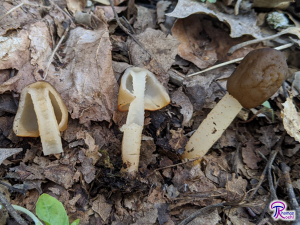
There are several species of Verpa, but only two are common in North America: Verpa bohemica and V. conica.1,2,4
V. bohemica has a highly wrinkled cap that is yellowish to brown. Sometimes the tips of the ridges are a darker shade of brown. The stipe is creamy white to yellowsh and usually darkens with age. V. bohemica is very interesting under the microscope because it features enormous spores (up to 85 µm!) and has two-spored asci (most asci make eight spores).2,5 The spores are so big you can actually see their shape using just a hand lens! This species is commonly known as the “Wrinkled Thimble Cap.” Some people call this species the “Early Morel,” but I prefer saving “morel” for true morels in the genus Morchella.2
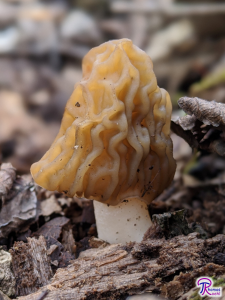
V. conica has a cap that is smooth to slightly wrinkled and tan to dark brown. The cap is not nearly as wrinkly as that of V. bohemica, so there is no chance of confusing the two species. The stipe is creamy white to yellowish and typically becomes darker as the mushroom ages.2,3,6
There are other species of Verpa, but only two have records from North America on Mushroom Observer: V. chicoensis and V. digitaliformis.4,7,8 V. chicoensis is similar to V. bohemica but its wrinkly cap develops smoky colors with age. Both Mushroom Observer records are from California.7,9 V. digitaliformis is similar to V. conica but features a cap dotted with tiny pits (at least, that’s how the name is used on Mushroom Observer – Persoon’s original description says the cap is wrinkled but not honeycomb-like; the usage may have changed since 1822). This species is recorded from both North America and Europe on Mushroom Observer.8,10,11
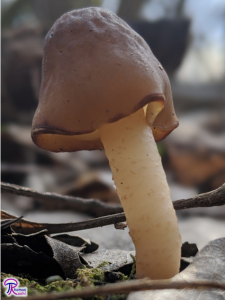
Ecology
Like morels, the ecological role of Verpa has not been fully figured out. Mycologists assume that verpas are mycorrhizal, since they grow from the ground in forests (both hardwood and conifer). Verpas appear in early spring before morels, or during winter in warm climates like the West Coast of North America.2,5,6 None of the species are common, but they can be found all across the northern hemisphere.2,12 It took me five years of mushroom hunting before I finally saw a verpa, which gives you an idea of how uncommon these mushrooms are. When I did finally find V. bohemica the patch I found produced about 100 mushrooms over the course of a week, so you can still find a lot of these mushrooms even if you don’t see them very often.
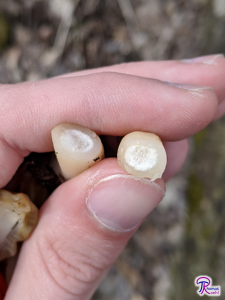
Similar Species
V. bohemica bears a striking resemblance to morels, especially Morchella punctipes (the Half-Free Morel, FFF#211). Two factors easily separate verpas from morels: 1) verpas have a cap attached only at the tip while morels have a cap attached all the way to the base and 2) the stipe of a verpa is filled with cottony material while morels are hollow with a single cavity that runs from the base of the stalk to the tip of the cap. Additionally, V. bohemica has a wrinkled cap rather than a cap with distinct ridges and pits found in the morels.1,2,5
V. conica is a little more distinctive thanks to its smooth cap. You might confuse it with Leotia lubrica (FFF#188), although that species appears later in the year, has a slimy or gelatinous texture, and a cap that is more lollipop-like than thimble-like.
Verpas are also somewhat similar to false morels (FFF#034) and elfin saddles (FFF#035), which also have caps that attach only to the top of the stipe. False morels and elfin saddles can be easily distinguished by their caps that are highly lobed and stipes that are solid or chambered.
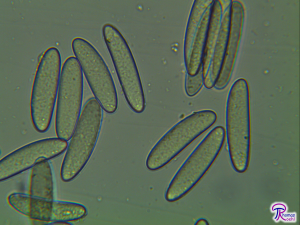
Edibility
There are mixed opinions on this group’s edibility. Some authors report verpas to be edible (only after being cooked), while others report them to be poisonous.2,3,13 People tell me that eating verpas is becoming more common with hardly anyone having a bad reaction, but I have no real evidence to support that claim. Symptoms of verpa poisoning are variable and may include gastrointestinal upset and loss of coordination.2 However, this may happen only when people eat too much of the mushrooms.13 If you choose to eat verpas, remember to try just a little bit the first time to determine how your body reacts to the species.
I have tried eating V. bohemica a couple times. I did not have any reactions, but I ate them in small amounts. The texture of the mushrooms was good, but the taste was not distinctive. If you choose not to eat this mushroom, you’re not missing much.
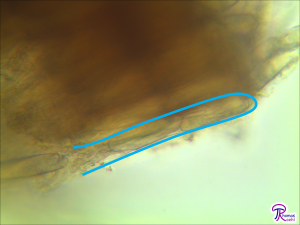
Taxonomy and Evolution
Verpa is placed in the family Morchellaceae, which also includes the morels (Morchella spp.) and the cup fungus genus Disciotis (see FFF#139, Disciotis venosa).1,4 Given how closely verpas are related to morels, it is perhaps no surprise that they look so similar. Verpas actually give us a hint about how morels evolved from cup fungi. First, the cup evolved a stalk to hold it above the ground, giving it better access to air currents. Next, the cup evolved to hang down around the stipe (like V. conica). Then the cup developed wrinkles to increase the surface area (like V. bohemica). Finally, the cap fused with the stipe to complete the morel shape (which probably uses less material and saves energy).14
| Kingdom | Fungi |
| Subkingdom | Dikarya |
| Division (Phylum) | Ascomycota |
| Subdivision (Subphylum) | Pezizomycotina |
| Class | Pezizomycetes |
| Subclass | Pezizomycetidae |
| Order | Pezizales |
| Family | Morchellaceae |
| Genus | Verpa Sw.4 |
| Species | Verpa bohemica (Krombh.) J. Schröt.15 Verpa chicoensis Copel.16 Verpa conica (O.F. Müll.) Sw.17 Verpa digitaliformis Pers.18 |
This post is not part of a key and therefore does not contain enough information to positively identify any mushroom. When collecting for the table, always use a local field guide to identify your mushrooms down to species. If you need a quality, free field guide to North American mushrooms, I recommend Michael Kuo’s MushroomExpert.com. Remember: when in doubt, throw it out!
See Further:
https://www.mushroomexpert.com/verpa_bohemica.html
https://www.mushroomexpert.com/verpa_conica.html
https://www.mykoweb.com/CAF/species/Verpa_conica.html
https://mushroomobserver.org/name/show_name/22195
https://mushroomobserver.org/name/show_name/43578
https://www.mushroomexpert.com/morchellaceae.html
https://www.fungimag.com/spring-2015-articles/Early%20Morels%20LR.pdf
Citations
- Kuo, M. The Morchellaceae: True Morels and Verpas. MushroomExpert.Com https://www.mushroomexpert.com/morchellaceae.html (2012).
- Beug, M. W., Bessette, A. & Bessette, A. R. Ascomycete fungi of North America: a mushroom reference guide. (2014).
- Wood, M. & Stevens, F. California Fungi—Verpa conica. The Fungi of California http://www.mykoweb.com/CAF/species/Verpa_conica.html.
- Verpa. Mycobank http://www.mycobank.org/BioloMICS.aspx?TableKey=14682616000000067&Rec=57604&Fields=All.
- Kuo, M. Verpa bohemica. MushroomExpert.Com https://www.mushroomexpert.com/verpa_bohemica.html (2019).
- Kuo, M. Verpa conica. MushroomExpert.Com https://www.mushroomexpert.com/verpa_conica.html (2019).
- Occurrence Map for Verpa chicoensis Copel. Mushroom Observer https://mushroomobserver.org/name/map/43578.
- Observation 45172: Verpa digitaliformis Pers. Mushroom Observer http://mushroomobserver.org/observer/show_observation/45172.
- Name: Verpa chicoensis Copel. Mushroom Observer http://mushroomobserver.org/name/show_name/43578.
- Observation 35113: Verpa digitaliformis Pers. Mushroom Observer http://mushroomobserver.org/observer/show_observation/35113.
- Persoon, C. H. Mycologia Europaea. vol. 1 https://books.google.com/books?id=8lY-AAAAcAAJ&printsec=frontcover&source=gbs_ge_summary_r&cad=0#v=onepage&q=digitaliformis&f=false (1822).
- Thimble Morels Genus Verpa. iNaturalist https://www.inaturalist.org/taxa/118001-Verpa.
- Davoli, P. & Sitta, N. Early Morels and Little Friars, or a Short Essay on the Edibility of Verpa bohemica. FUNGI vol. 8 4–9 https://www.fungimag.com/spring-2015-articles/Early%20Morels%20LR.pdf (2015).
- Volk, T. Disciotis venosa—- the veined cup fungus. Tom Volk’s Fungi https://botit.botany.wisc.edu/toms_fungi/may2008.html (2008).
- Verpa bohemica. Mycobank http://www.mycobank.org/BioloMICS.aspx?TableKey=14682616000000067&Rec=28841&Fields=All.
- Verpa chicoensis. Mycobank http://www.mycobank.org/BioloMICS.aspx?TableKey=14682616000000067&Rec=245756&Fields=All.
- Verpa conica. Mycobank http://www.mycobank.org/BioloMICS.aspx?TableKey=14682616000000067&Rec=28845&Fields=All.
- Verpa digitaliformis. Mycobank http://www.mycobank.org/BioloMICS.aspx?TableKey=14682616000000067&Rec=28849&Fields=All.

![#071: Flammulina velutipes, The Velvet Foot [Archived]](https://www.fungusfactfriday.com/wp-content/themes/hueman/assets/front/img/thumb-medium-empty.png)
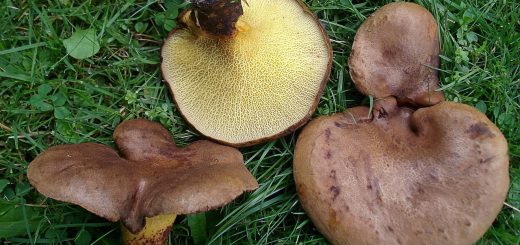
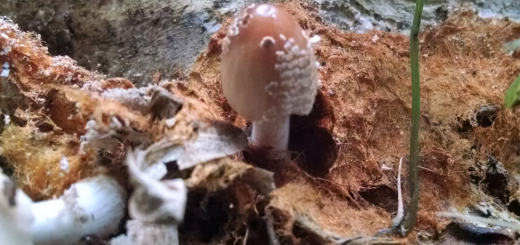





![#011: Characteristics of Kingdom Fungi [Archived]](https://www.fungusfactfriday.com/wp-content/themes/hueman/assets/front/img/thumb-small-empty.png)

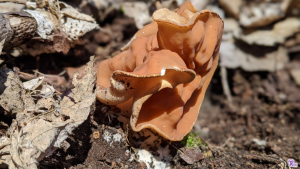
5 Responses
[…] (FFF#067) have ridges that are very similar to the ones found on morels. However, the head of a verpa […]
[…] (FFF#067) are also similar but their ridges and pits are less well defined and the cap is attached only at […]
[…] out which species yours is, it’s OK. There are also a few false morels (FFF#0344) and verpas (FFF#067) that beginners can confuse with Yellow Morels. These can easily be eliminated by morphological […]
[…] are a number of morel look-alikes, including verpas (FFF#067) and false morels (FFF#034). Verpas are closely related to morels and look very similar to […]
[…] (FFF#067) are also similar to false morels. Like with morels, the easiest way to tell these species apart is […]